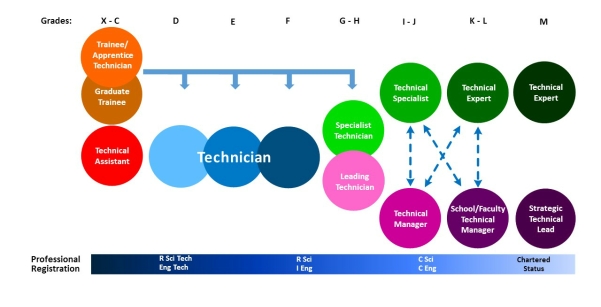Career Framework for Technical Staff

Purpose of the Framework
The overall purpose of the Career Framework for Technical Staff* is to provide a multi-functional tool. It gives clarity to the different levels of technical work, provides supporting information to describe those levels, informs individuals to help them manage their careers, and guides future workforce planning. It also introduces some consistent language when describing various technical roles.
The Framework was approved by UPARC (University Planning and Resources Committee) in June 2017. It will be gradually introduced over an extended period as the career framework for all our technical resourcing*. It is expected to have a slower, more considered overall impact on the shape of technical services as this tool starts to be applied by all the key stakeholders to make informed decisions on staffing and career related matters.
Who is it for?
In addition to the main Career Framework model and descriptors there is also a Technical Role Types Information Toolkit. Mapped to the framework model, this gives staff access to outline profiles for each of 29 identified types of technical role across research, facilities, teaching and technical management.
The Career Framework will be particularly relevant to three key stakeholder groups:
1. Individual members of technical staff
2. Technical Managers and equivalent roles (including Professional Services Managers and Principle Investigators)
3. Other Key Stakeholders, e.g. HR, Finance and service receivers.
How can they use it?
1. Individual members of Technical Staff
For individual members of technical staff this framework provides a career planning tool. It makes the range of technical work in the University more visible and more clearly defined by introducing consistent language when describing roles and making it easier to recognise appropriate opportunities when they arise, e.g. role titles that clearly reflect the level of technical work and map to the framework. The suite of information available through the Career Framework can also help individual members of staff to assess how their current skill and experience set compares to those required for other types of roles.
In addition to the main Career Framework model and descriptors there is also a Technical Role Types Information Toolkit. Mapped to the framework model, this gives staff access to outline profiles for each of 29 identified types of technical role across research, facilities, teaching and technical management. Each role type profile provides information about:
- the broad purpose of that type of role
- the range of responsibilities the role may include
- the experience, knowledge and other criteria that may be asked for
From this information individuals can proactively review their own skill set to identify transferable skills and experience. They can review the requirements of other roles and identify matches and gaps with their own situation, and this can help individuals to be better prepared when vacancies do arise. This could also help to inform conversations about development in staff review. By providing this information individuals should be better able to see the range of role types and understand role requirements. They will be able to gauge better for themselves which other types or level of role may be suitable for them, possibly in other schools/faculties or disciplines, to develop their careers.
It should be remembered that career development is a partnership, not a right. The University undertakes to set clear expectations; provide a framework to facilitate careers to develop; and to provide appropriate development support, however individuals need to take responsibility for their own career, at the University and beyond, and for their personal development throughout their career.
2. Technical Managers and equivalent roles
For this stakeholder group the principle purpose of the career framework is as a workforce planning tool and can be utilised in the following ways:
- To help determine the size and shape of the service going forward, both locally and organisationally, to ensure we can meet current and future service demands and recruit and develop staff accordingly
- When identifying and planning how the knowledge and skills required to meet future demands will be developed or acquired, e.g. informing development discussions in staff review, or in recruitment decisions
- In succession planning, e.g. choosing appropriate entry routes, or in recruitment decisions
- To align all new roles to the framework to ensure consistency, e.g. grading
Note: The descriptors developed to underpin the model have been evaluated through University of Bristol Job Evaluation Scheme (UBJES), however these should be used in conjunction with the generic Professional and Administrative grade descriptors, not instead of them.
3. Other Key Stakeholders, e.g. HR, service receivers
Other key stakeholders are identified as those involved in the management of Professional Services staff (which includes technical staff) at school and faculty levels, recruitment of technical staff, Finance, and services receivers. These include academic colleagues, Faculty and School Managers, Finance and HR colleagues.
The purpose of the Framework for these stakeholders is to increase clarity and understanding of the range of technical work, and to introduce more consistent language in discussions on technical staffing matters.
If referring to or using the descriptors that accompany the model,
please note: The descriptors developed to underpin the model have been evaluated through University of Bristol Job Evaluation Scheme (UBJES), however these should be used in conjunction with the generic Professional and Administrative grade descriptors, not instead of them.
*Definition of in-scope staff
The members of technical staff who are included within the remit of the Technical Staff and Services Strategy and the Career Framework for Technical Staff are defined as those who are engaged directly in supporting academic related work, i.e. teaching and research. These are primarily the technical staff based in the Faculties rather than those in the Divisions engaged in other support activities.